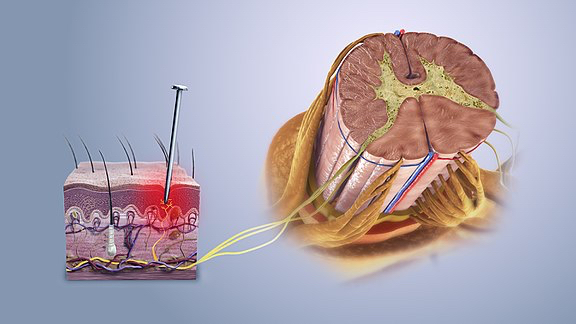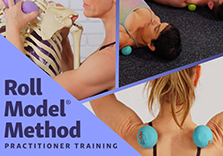
Pain is a natural part of life. We’ve all experienced it at one point or another. Common complaints I hear as a movement educator are: back pain, knee pain, hip pain, abdominal pain, shoulder pain, neck pain… the list goes on and on.
But what do you do when pain has become a constant companion? When you fear it will never go away?
How to Take Pain Management into Your Own Hands
Understanding the origin of pain and science of pain is the first step. Adopting some basic self-care routines to help redirect your attention, strengthen your sense of control and improve your body awareness comes next. Below we will go beyond pain management, and look at how to actually disrupt the pathways of pain.
The below information is meant to offer insight into the workings of pain. It is not meant as medical advise. If you are experiencing pain, please consult your doctor before beginning any self-care or exercise program.
Origins of Pain

The origin of pain can be related to tissue or nerve damage. Pain can also have a mental or an emotional origin, or an undetermined cause. All types of pain–or nociceptive input–stem from the brain’s interpretation of a situation or a stimulus as harmful or threatening.
This means that nociceptive signals are always real, but they’re not always related to tissue damage or an actual threat to the system. This is a very important message for your brain to understand if you are dealing with pain. By understanding this, you can begin to discern if the pain is actually necessary for your survival.
Your Brain and Chronic Pain
Our perception of pain is related to our prior experiences but also to our expectations: our mood and attentional focus.
The brain’s ability to adapt and remodel neurological pathways in order to improve the communication between different regions in the brain, or between the brain and other parts of the body, is usually a positive thing. However, when it comes to pain, it means that we unknowingly can create “pain super-highways.”
Pain super-highways are pathways that become the preferred and most frequently means of communication. They are especially prevalent during periods of emotional or physical stress and imbalance.

In essence, we train the brain to become better at feeling and communicating pain. This may lead the brain to interpret any uncomfortable or irritating signal as pain–just because the signal is traveling along the most frequently used pathway.
Another important concept to understand about pain is that our nervous system can become sensitized to nociceptive signals. This is why it’s important to get a correct diagnosis early, instead of ignoring persistent pain.
If you ignore the pain you run the risk of increasing your nervous system’s sensitivity to pain, while also decreasing your ability to localize and specify the nociceptive signals. In other words, even the lightest touch or stimulus can cause a global overwhelming pain sensation.
4 Effective Self-care Tools to for Pain Management
Our natural reaction to pain (or a fear of feeling pain) is avoidance. We avoid any movement, position or situation we believe is associated with, or is causing, discomfort. This strategy can be debilitating for someone with chronic pain. However, you don’t want to completely ignore pain signals. So what do you do?
The following suggestions are inspired by methods often used in physical therapy but with a Yoga tune Up® twist.
1. Use the Breath to Calm Yourself Down
The first step when managing chronic pain is to help the nervous system calm down. Your brain is more sensitive to nociceptive signals when you’re stressed, which means that learning how to relax and how to stimulate the parasympathetic nervous system can be helpful. The best way to do this is by stimulating the respiratory diaphragm with the breath. The diaphragm is connected to the Vagus nerve, which controls the parasympathetic response. Deep abdominal breathing is therefore the quickest way to flip the switch in your brain and enter a more calm and relaxed state.

2. Create a Strong Internal Resolve
The next step is to create a mindset that can help redirect your attention, create a sense of control and help to retrain your brain. The term sankalpa is used in yoga when setting a deeply rooted positive intention for a specific aspect of your life. Creating a sankalpa in the form of a short sentence that’s easy to repeat will plant a powerful seed in your mind. A seed that can grow and serve as a guide to help you craft new and pain-free pathways in your brain.
3. Induce Global Relaxation
The third step is to improve your proprioception by using a Coregeous® ball. Proprioception is your ability to sense the position, orientation and movement of different body parts. It’s also a sensory information system that’s inversely related to nociception. In other words, proprioceptive signals tend to inhibit nociception, which means that this can be an effective strategy for reducing pain.
Improved proprioception can also help your body awareness and in the long run develop your ability to differentiate between different types of nociceptive signals. Global shear with a Coregeous® ball on the floor or at the wall is a good starting point when trying to improve proprioception.
The soft pressure from the ball stimulates receptors in your muscles and tendons as well as in the different layers of fascia. Input that can help your brain re-interpret signals that were previously thought of as nociception and therefore interpreted by the brain as pain.
4. Re-Introduce Movement
After the first three steps you can introduce movement to further improve proprioception while also increasing strength and building confidence. This will further enhance the positive spiral toward less and less pain.
If you are a yoga teacher or a movement educator keep in mind that it’s not our job to diagnose or treat injuries or any form of pain (unless you’re licensed to do so). When working with clients in pain remember to stay within your scope of practice and, as one of my mentors Sarah Court says, “when in doubt refer out.”
Special thanks to Sarah Court, DPT and Tiffany Cruikshank for insight and information that helped inspire this post.
Disclaimer: Please consult a doctor or physical therapist if you are experiencing pain that hasn’t received medical attention… The suggestions above are not a substitute for seeking help by a Medical Doctor or Physical Therapist.










The first time I learned that proprioception and nociception had an inverse relationship with each other (which was during the Roll Model Method training!) it was mind-blowing and reinforced the importance of a regular mindful movement practice. It’s super cool to add the new layer of information that it is in part because building better proprioceptive skills creates new neural pathways for the input signals to travel – instead of the well-trodden “pain super-highways” – which enables the brain to better interpret and understand those signals.
really enjoyed this article, I will be sharing this article with my partner who recently broke his back so that he can preventively apply these techniques.
The research on pain science is fascinating! When I was dancing professionally, any sign of pain would set off alarm bells that an impeding injury might affect my livelihood and passion. It was very stressful, which probably did not help in alleviating the pain! I wish I had understood a little more about this field back then.
I’d like to hear more from you, and YTU, on pain management. This is a huge topic. At some point we all deal with it and learning healthier solutions is better than popping a pill every day. Thanks for introducing the topic. Look forward to more.
Thank you for your tools for dealing with pain. It helps knowing, and teaching, that pain is normal and there are strategies for managing pain. Thank you!
Wow! Absolutely fascinating. This is an area I am really excited to explore. Thank you for sharing the effective tools.
Thank you for providing the Coregeous ball example for context. I recently took the Breath & Bliss Immersion and had a similar experience of perceived pain when applying pressure to the abdomen. Through PNF I was able to distinguish pain from what was really an uncommon sensation. As someone who consistently participants in endurance training, I’m excited to apply this concept and techniques to “pains” I’m feeling in the moment.
Thank you Annelie, this seems to me a very safe plan “with a Yoga tune Up® twist” to work with clients who are in in a moment of pain and really scared of any movement. Great, thank you for sharing!
neuropathic pain is the worst, I have allodynia – I’ve tried everything and then some. Fabric on my legs feels like a burning sensation. Any suggestions?
Great tips! I had no idea that improving proprioception can potentially decrease our sensation of pain! There’s this one test that I’ve seen occupational therapists do to help clarify which sensations are safe, and which ones are potentially harmful. It involves touching the skin with different objects, starting with soft feathers Andrea a light touch, moving to things like sandpaper and blunt spikes, with a firmer touch. I see now that this therapeutic approach improves proprioception to allow patients to re-assess, respond anew to nocioception, and then generate more discerning neural pathways to stimulus, where there may have previously been only a pain response.
I was also very intrigued by the powerful role that the mind plays in up-regulating or down-regulating a pain response. Do you have any good mantra’s to use as a sankalpa to overcome pain that is perceived as threatening but is not physically dangerous?